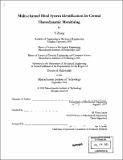Multi-channel blind system identification for central hemodynamic monitoring
Author(s)
Zhang, Yi, 1973-
DownloadFull printable version (7.967Mb)
Other Contributors
Massachusetts Institute of Technology. Dept. of Mechanical Engineering.
Advisor
H. Harry Asada.
Terms of use
Metadata
Show full item recordAbstract
Multi-channel Blind System Identification (MBSI) is a technique for estimating both an unknown input and unknown channel dynamics from simultaneous output measurements at different channels through which the input signal propagates. It is a powerful tool particularly for the identification and estimation of dynamical systems in which a sensor, for measuring the input, is difficult to place. All of the existing MBSI algorithms, however, are not applicable to multi-channel systems sharing common dynamics among the channels, since these algorithms, by nature, exploit "differences" among the multiple channel dynamics. This requirement renders the MBSI algorithms useless in systems that have both a lumped-parameter nature and a distributed nature; all channels in a system of this type share poles dictated by the lumped-parameter dynamics. To overcome this difficulty, this thesis investigates a new approach, Intermediate Input Identification (IIID). This thesis proves that the distinct dynamics in each channel can be identified up to a scalar factor even when common dynamics are present. Based on this discovery, the MBSI problem is reformulated and an intermediate input is introduced, which integrates the original system input and the common dynamics shared by all the channels. The two-step IIID approach is developed to solve the problem: first, the distinct dynamics are identified from the outputs; second, the common dynamics are identified from the intermediate input by exploiting the zero-input response of the system. The identifiability conditions are thoroughly investigated. The sufficient and necessary conditions and the relationship between the linear-complexity condition of the original input and that of the intermediate input are derived in this thesis. (cont.) This thesis also develops a central hemodynamic monitoring scheme based on IIID. The similarities between the structure of a digital wireless communication system and that of the cardiovascular system are explained. The input, the common dynamics and the distinct dynamics in the cardiovascular multi-channel system are derived based on the determinants of arterial blood pressure. Analysis of the data from a cardiovascular simulator and animal experiments verify the validity of this scheme. The positive results demonstrate that the IIID approach could open up the possibility for noninvasive central hemodynamic monitoring, which could significantly reduce the risks to which patients are exposed.
Description
Thesis (Ph. D.)--Massachusetts Institute of Technology, Dept. of Mechanical Engineering, 2002. Includes bibliographical references (leaves 89-91).
Date issued
2002Department
Massachusetts Institute of Technology. Department of Mechanical EngineeringPublisher
Massachusetts Institute of Technology
Keywords
Mechanical Engineering.